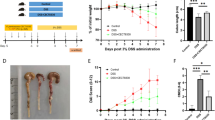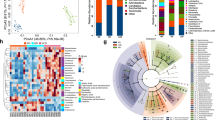Abstract
Purpose
Growing evidence shows that nutrient metabolism affects inflammatory bowel diseases (IBD) development. Previously, we showed that deficiency of indoleamine 2,3-dioxygenase 1 (Ido1), a tryptophan-catabolizing enzyme, reduced the severity of dextran sulfate sodium (DSS)-induced colitis in mice. However, the roles played by intestinal microbiota in generating the differences in disease progression between Ido1+/+ and Ido1−/− mice are unknown. Therefore, we aimed to investigate the interactions between the intestinal microbiome and host IDO1 in governing intestinal inflammatory responses.
Methods
Microbial 16s rRNA sequencing was conducted in Ido1+/+ and Ido1−/− mice after DSS treatment. Bacteria-derived tryptophan metabolites were measured in urine. Transcriptome analysis revealed the effects of the metabolite and IDO1 expression in HCT116 cells. Colitis severity of Ido1+/+ was compared to Ido1−/− mice following fecal microbiota transplantation (FMT).
Results
Microbiome analysis through 16S-rRNA gene sequencing showed that IDO1 deficiency increased intestinal bacteria that use tryptophan preferentially to produce indolic compounds. Urinary excretion of 3-indoxyl sulfate, a metabolized form of gut bacteria-derived indole, was significantly higher in Ido1−/− than in Ido1+/+ mice. Transcriptome analysis showed that tight junction transcripts were significantly increased by indole treatment in HCT116 cells; however, the effects were diminished by IDO1 overexpression. Using FMT experiments, we demonstrated that bacteria from Ido1−/− mice could directly attenuate the severity of DSS-induced colitis.
Conclusions
Our results provide evidence that a genetic defect in utilizing tryptophan affects intestinal microbiota profiles, altering microbial metabolites, and colitis development. This suggests that the host and intestinal microbiota communicate through shared nutrient metabolic networks.




Similar content being viewed by others
References
O'Hara AM, Shanahan F (2006) The gut flora as a forgotten organ. EMBO Rep 7(7):688–693
Sartor RB (2008) Microbial influences in inflammatory bowel diseases. Gastroenterology 134(2):577–594
Scott KP, Gratz SW, Sheridan PO, Flint HJ, Duncan SH (2013) The influence of diet on the gut microbiota. Pharmacol Res 69(1):52–60
Hesla HM, Stenius F, Jäderlund L, Nelson R, Engstrand L, Alm J, Dicksved J (2014) Impact of lifestyle on the gut microbiota of healthy infants and their mothers—the ALADDIN birth cohort. FEMS Microbiol Ecol 90(3):791–801
Shin J-H, Sim M, Lee J-Y, Shin D-M (2016) Lifestyle and geographic insights into the distinct gut microbiota in elderly women from two different geographic locations. J Physiol Anthropol 35(1):31–39
Yatsunenko T, Rey FE, Manary MJ, Trehan I, Dominguez-Bello MG, Contreras M, Magris M, Hidalgo G, Baldassano RN, Anokhin AP, Heath AC, Warner B, Reeder J, Kuczynski J, Caporaso JG, Lozupone CA, Lauber C, Clemente JC, Knights D, Knight R, Gordon JI (2012) Human gut microbiome viewed across age and geography. Nature 486(7402):222–227
Grzeskowiak L, Collado MC, Mangani C, Maleta K, Laitinen K, Ashorn P, Isolauri E, Salminen S (2012) Distinct gut microbiota in southeastern African and northern European infants. J Pediatr Gastroenterol Nutr 54(6):812–816
Dehingia M, Talukdar NC, Talukdar R, Reddy N, Mande SS, Deka M, Khan MR (2015) Gut bacterial diversity of the tribes of India and comparison with the worldwide data. Sci Rep 5:18563
Senghor B, Sokhna C, Ruimy R, Lagier J-C (2018) Gut microbiota diversity according to dietary habits and geographical provenance. Hum Microbiome J 7:1–9
Bassett SA, Young W, Barnett MP, Cookson AL, McNabb WC, Roy NC (2015) Changes in composition of caecal microbiota associated with increased colon inflammation in interleukin-10 gene-deficient mice inoculated with enterococcus species. Nutrients 7(3):1798–1816
Gálvez EJ, Iljazovic A, Gronow A, Flavell R, Strowig T (2017) Shaping of intestinal microbiota in Nlrp6-and Rag2-deficient mice depends on community structure. Cell Rep 21(13):3914–3926
Kim CJ, Kovacs-Nolan JA, Yang CB, Archbold T, Fan MZ, Mine Y (2010) L-Tryptophan exhibits therapeutic function in a porcine model of dextran sodium sulfate (DSS)-induced colitis. J Nutr Biochem 21(6):468–475
Shizuma T, Mori H, Fukuyama N (2013) Protective effect of tryptophan against dextran sulfate sodium- induced experimental colitis. Turk J Gastroenterol 24(1):30–35
Ciorba MA (2013) Indoleamine 2, 3 dioxygenase (IDO) in intestinal disease. Curr Opin Gastroenterol 29(2):146
Shon W-J, Lee Y-K, Shin JH, Choi EY, Shin D-M (2015) Severity of DSS-induced colitis is reduced in Ido1-deficient mice with down-regulation of TLR-MyD88-NF-kB transcriptional networks. Sci Rep 5:17305
Cole JR, Wang Q, Fish JA, Chai B, McGarrell DM, Sun Y, Brown CT, Porras-Alfaro A, Kuske CR, Tiedje JM (2014) Ribosomal Database Project: data and tools for high throughput rRNA analysis. Nucleic Acids Res 42(Database issue):D633–642
Edgar RC, Haas BJ, Clemente JC, Quince C, Knight R (2011) UCHIME improves sensitivity and speed of chimera detection. Bioinformatics 27(16):2194–2200
Wang GGM, Tiedje JM, Cole JR (2007) Naive Bayesian classifier for rapid assignment of rRNA sequences into the new bacterial taxonomy. Appl Environ Microbiol 73(16):5261–5267
Lee Y-K, Lee HB, Shin D-M, Kang MJ, Yi EC, Noh S, Lee J, Lee C, Min C-K, Choi EY (2014) Heme-binding-mediated negative regulation of the tryptophan metabolic enzyme indoleamine 2, 3-dioxygenase 1 (IDO1) by IDO2. Exp Mol Med 46(11):e121
Zhang JD, Schindler T, Kung E, Ebeling M, Certa U (2014) Highly sensitive amplicon-based transcript quantification by semiconductor sequencing. BMC Genom 15:565
Li Z, Huang J, Zhao J, Chen C, Wang H, Ding H, Wang DW, Wang DW (2014) Rapid molecular genetic diagnosis of hypertrophic cardiomyopathy by semiconductor sequencing. J Transl Med 12:173
Hartley JW, Chattopadhyay SK, Lander MR, Taddesse-Heath L, Naghashfar Z, Morse HC 3rd, Fredrickson TN (2000) Accelerated appearance of multiple B cell lymphoma types in NFS/N mice congenic for ecotropic murine leukemia viruses. Lab Invest 80(2):159–169
Wu H-J, Ivanov II, Darce J, Hattori K, Shima T, Umesaki Y, Littman DR, Benoist C, Mathis D (2010) Gut-residing segmented filamentous bacteria drive autoimmune arthritis via T helper 17 cells. Immunity 32(6):815–827
Karmarkar D, Rock KL (2013) Microbiota signalling through MyD88 is necessary for a systemic neutrophilic inflammatory response. Immunology 140(4):483–492
Reikvam DH, Erofeev A, Sandvik A, Grcic V, Jahnsen FL, Gaustad P, McCoy KD, Macpherson AJ, Meza-Zepeda LA, Johansen F-E (2011) Depletion of murine intestinal microbiota: effects on gut mucosa and epithelial gene expression. PLoS ONE 6(3):e17996
Segata N, Izard J, Waldron L, Gevers D, Miropolsky L, Garrett WS, Huttenhower C (2011) Metagenomic biomarker discovery and explanation. Genome Biol 12(6):R60
Reunanen J, Kainulainen V, Huuskonen L, Ottman N, Belzer C, Huhtinen H, de Vos WM, Satokari R (2015) Akkermansia muciniphila adheres to enterocytes and strengthens the integrity of epithelial cell layer. Appl Environ Microbiol 81(11):3655–3662
Sridharan GV, Choi K, Klemashevich C, Wu C, Prabakaran D, Pan LB, Steinmeyer S, Mueller C, Yousofshahi M, Alaniz RC (2014) Prediction and quantification of bioactive microbiota metabolites in the mouse gut. Nat Commun 5:5492
Lee J-H, Lee J (2010) Indole as an intercellular signal in microbial communities. FEMS Microbiol Rev 34(4):426–444
Yokoyama M, Carlson J (1979) Microbial metabolites of tryptophan in the intestinal tract with special reference to skatole. Am J Clin Nutr 32(1):173–178
Russell WR, Duncan SH, Scobbie L, Duncan G, Cantlay L, Calder AG, Anderson SE, Flint HJ (2013) Major phenylpropanoid-derived metabolites in the human gut can arise from microbial fermentation of protein. Mol Nutr Food Res 57(3):523–535
Wikoff WR, Anfora AT, Liu J, Schultz PG, Lesley SA, Peters EC, Siuzdak G (2009) Metabolomics analysis reveals large effects of gut microflora on mammalian blood metabolites. Proc Natl Acad Sci USA 106(10):3698–3703
Sokol H, Lay C, Seksik P, Tannock GW (2008) Analysis of bacterial bowel communities of IBD patients: what has it revealed? Inflamm Bowel Dis 14(6):858–867
Gupta NK, Thaker AI, Kanuri N, Riehl TE, Rowley CW, Stenson WF, Ciorba MA (2012) Serum analysis of tryptophan catabolism pathway: correlation with Crohn's disease activity. Inflamm Bowel Dis 18(7):1214–1220
Sun J (2018) Dietary vitamin D, vitamin D receptor, and microbiome. Curr Opin Clin Nutr Metab Care 21(6):471
Ghazalpour A, Cespedes I, Bennett BJ, Allayee H (2016) Expanding role of gut microbiota in lipid metabolism. Curr Opin Lipidol 27(2):141–147
Gurtner GJ, Newberry RD, Schloemann SR, McDonald KG, Stenson WF (2003) Inhibition of indoleamine 2,3-dioxygenase augments trinitrobenzene sulfonic acid colitis in mice. Gastroenterology 125(6):1762–1773
Takamatsu M, Hirata A, Ohtaki H, Hoshi M, Hatano Y, Tomita H, Kuno T, Saito K, Hara A (2013) IDO1 plays an immunosuppressive role in 2, 4, 6-trinitrobenzene sulfate-induced colitis in mice. J Immunol 191(6):3057–3064
Shimada Y, Kinoshita M, Harada K, Mizutani M, Masahata K, Kayama H, Takeda K (2013) Commensal bacteria-dependent indole production enhances epithelial barrier function in the colon. PLoS ONE 8(11):e80604
Bansal T, Alaniz RC, Wood TK, Jayaraman A (2010) The bacterial signal indole increases epithelial-cell tight-junction resistance and attenuates indicators of inflammation. Proc Natl Acad Sci USA 107(1):228–233
Poritz LS, Garver KI, Green C, Fitzpatrick L, Ruggiero F, Koltun WA (2007) Loss of the tight junction protein ZO-1 in dextran sulfate sodium induced colitis. J Surg Res 140(1):12–19
Mankertz J, Schulzke JD (2007) Altered permeability in inflammatory bowel disease: pathophysiology and clinical implications. Curr Opin Gastroenterol 23(4):379–383
Zelante T, Iannitti RG, Cunha C, De Luca A, Giovannini G, Pieraccini G, Zecchi R, D'Angelo C, Massi-Benedetti C, Fallarino F, Carvalho A, Puccetti P, Romani L (2013) Tryptophan catabolites from microbiota engage aryl hydrocarbon receptor and balance mucosal reactivity via interleukin-22. Immunity 39(2):372–385
Oh S, Go GW, Mylonakis E, Kim Y (2012) The bacterial signalling molecule indole attenuates the virulence of the fungal pathogen Candida albicans. J Appl Microbiol 113(3):622–628
Lee JH, Cho HS, Kim Y, Kim JA, Banskota S, Cho MH, Lee J (2013) Indole and 7-benzyloxyindole attenuate the virulence of Staphylococcus aureus. Appl Microbiol Biotechnol 97(10):4543–4552
Hashimoto T, Perlot T, Rehman A, Trichereau J, Ishiguro H, Paolino M, Sigl V, Hanada T, Hanada R, Lipinski S, Wild B, Camargo SM, Singer D, Richter A, Kuba K, Fukamizu A, Schreiber S, Clevers H, Verrey F, Rosenstiel P, Penninger JM (2012) ACE2 links amino acid malnutrition to microbial ecology and intestinal inflammation. Nature 487(7408):477–481
Acknowledgements
This research was supported by the Seoul National University Research Grant.
Author information
Authors and Affiliations
Contributions
This study was designed, directed, and coordinated by D-MS, EYC, and J-HS. HCM, D-MS, and EYC supervised the project. J-HS, W-JS, and Y-KL acquired data and performed the animal experiments. Detection of metabolites in urine was analyzed by BK and J-YC. J-HS analyzed and interpreted data. JHS and DMS wrote the main paper, and Y-KL and BK wrote the Materials and Methods section. COJ gave technical and material support. All authors discussed the results and implications and commented on the manuscript at all stages.
Corresponding authors
Ethics declarations
Conflict of interest
The authors declare that they have no conflict of interest.
Ethical approval
The protocol of this study was approved by the Institutional Animal Care and Use Committee of the Institute of Laboratory Animal Resources, Seoul National University (Institutional Animal Care and Use Committee permit number: SNU-150119-5).
Electronic supplementary material
Below is the link to the electronic supplementary material.
Rights and permissions
About this article
Cite this article
Shin, JH., Lee, YK., Shon, WJ. et al. Gut microorganisms and their metabolites modulate the severity of acute colitis in a tryptophan metabolism-dependent manner. Eur J Nutr 59, 3591–3601 (2020). https://doi.org/10.1007/s00394-020-02194-4
Received:
Accepted:
Published:
Issue Date:
DOI: https://doi.org/10.1007/s00394-020-02194-4




